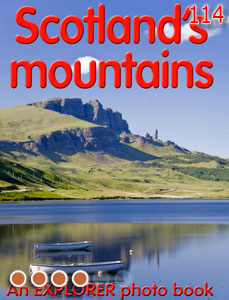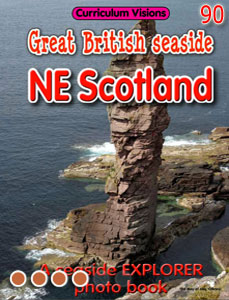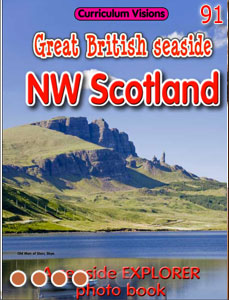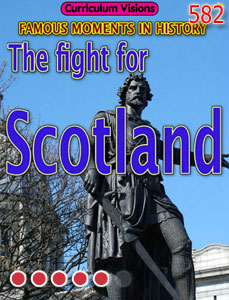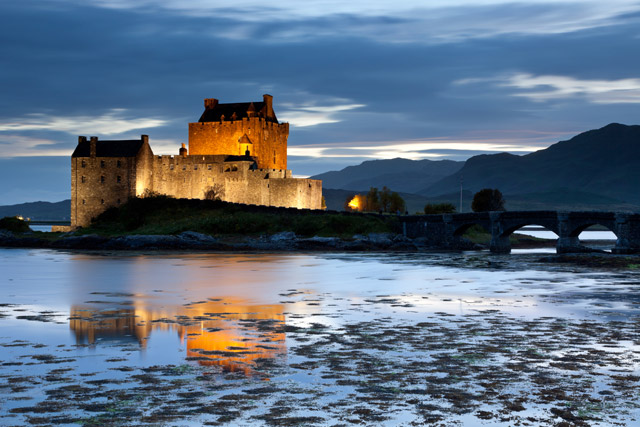Scotland makes up the northern third of Great Britain, although its population of about 4 million is dwarfed by the 54 million in England. It has nearly 800 islands, most of which lie off the western coast. Scotland's border with England runs from the Solway Firth just north of Carlisle to the Tweed, just north of Berwick. Scotland's islands form what is almost a series of stepping stones to Ireland. Furthermore, Ireland's mainland is just 30km from the peninsula of Kintyre in SW Scotland. This accounts for why Irish influence has been considerable throughout Scotland's history, and especially its early history.
The islands that make up Orkney and Shetland are similarly almost stepping stones to Norway, and both of these island groups were under the control of Norway until 1472.
Scotland is essentially a hilly and mountainous country with a small lowland strip (The Midland Valley) lying between the Southern Uplands and the Scottish Highlands. Most of Scotland's people live in the Midland Valley, and most of those in the main cities of Glasgow and Edinburgh. Glasgow is the largest city, and the biggest centre of businesses and factories, and one of the powerhouses of the Industrial Revolution. It has a population of 2.8 million. Edinburgh is much smaller, but it is the capital city, it is famous for its financial businesses, such as banks and insurance companies, and has a population of 780,000. Scotland's highest peak is Ben Nevis (1,344m/ 4,409ft). The most famous rivers are the Clyde (Glasgow) and Forth (Edinburgh), but the longest river is the River Tay, with a course of some 190km.
The whole of Scotland was covered by ice sheets during the Ice Age. Because it was under the ice, there were no peaks standing above the ice, and so there are no sharp peaks as you find, say, in the Rockies. Even Ben Nevis has a rounded summit. The other effect of that was that ice could flow down valleys, scouring them deeper and wider and making U-shaped valleys. Those valleys are now filled by water to make lochs (finger lakes). In some cases the ice spilled from one valley to another, and as it did so, it scoured a trench through the ridge between valleys. These trenches are invaluable today, for they make passes that allow people to get about more easily. The Pass of Glencoe is one scoured pass of this kind.
Underneath the land in the Midland Valley of Scotland are thick seams of coal and iron. These were the rocks that were mined for centuries.
Punching up through these rocks are the pipes of ancient volcanoes. The rocks in these pipes are very hard. The rest of the volcanoes have gone, but the pipes still make tall strongholds which were ideal for building forts and castles. Edinburgh and Stirling castles are both on volcanic pipes. Today they make for dramatic sites for tourists.
When it comes to weather, Scotland is a country of two halves. The western half has milder winters and cooler summers. It is directly in the path of a warm current of ocean water called the North Atlantic Drift. This also brings moisture and rain. Many low pressure systems (depressions) track across Scotland as well. Added to this is the effect of the mountains, which causes the air to rise and cool, releasing even more moisture. As a result, the western side of Scotland gets the heaviest rainfalls and cloudiest conditions of the UK. By contrast, the eastern side of Scotland lies in the shelter of the mountains and the westerly winds. It is called a rainshadow area. It gets much less rain and more sunshine. The Moray Firth is one of the sunniest places in the UK. But without the warm ocean current, the east has colder winters, although in compensation, without the cloud it gets hotter summers. That is why most crops grown in Scotland are in fields along the east coast, while the western fields are given over to animal grazing.
Scotland has been peopled for as long as anywhere else in the UK. The oldest villages ever discovered in the UK are found in Orkney at a place called Skara Brae. This village is 6,000 years old. In fact, the Isles of Orkney and Shetland have a remarkable collection of remains from Stone Age times, including not just villages, but spectacular stone circles. This would have been possible because, at this time, the whole of the UK was much warmer than it is today.
By the time the Romans arrived in southern Britain, Scotland was well peopled, with the dominant tribes having come over from Ireland. The original Scottish tribes were called Picts, but they were replaced by the Irish tribes, the Scottie, from whom Scotland gets its name. That would not be the last of the influence of Ireland, but it was the most important.
The Romans called the area of Scotland 'Caledonia', and found that capturing it was more than they were able to do. Their supply lines came from the south, and they became more and more stretched as they went north. The tribes of Scotland also had a different idea of warfare to the Romans. They did not have pitched battles, but used their smaller numbers to great effect by making hit and run raids on forts. Although the Romans did travel the whole length of Scotland, the difficulty of controlling the Scottish tribes eventually made the Romans build defensive walls. The most famous is Hadrian's Wall, now just south of the Scotland/England border. There was a further wall, between the Forth and the Clyde. This was the Antoninne Wall, but it did not last for more than a few decades.
Then, in the 4th century the Romans left the lands of Britain. They had occupied England much more forcibly than Scotland, and left the English poorly equipped to look after themselves. So the Scottish tribes seized the chance to attack the English, forcing the English to seek help from the Saxons, Angles and Jutes. This was to hold the line against the Scots, but at the expense of England being taken over by the Anglo-Saxons, as it would remain for 600 years.
Because of this, the Scottish tribes developed separately from the Anglo-Saxons of England. They retained more of the Old British ways, rather than having Anglo-Saxon ways forced on them. The same was true in Wales and in Ireland.
Battles between the Scottish tribes eventually led to the rise of one tribe, and the rise of its leader to be king of Scotland. Remember that, at this time, Vikings took over large parts of Scotland. They were to hold on to the Northern Isles until the 15th century. So as Scotland became one kingdom during Medieval times, it took over lands to the southeast that were Anglo-Saxon speaking, and lands from Caithness northwards that were Norse speaking, and the lands of the west that were Gaelic speaking.
Scotland took on many of the ideas from the south in terms of defence. During the reign of King David a feudal system was introduced, with lords and serfs. The first fortified towns (called burghs, similar to Saxon burhs) developed. Normans and others from France also came to Scotland and brought ideas of knights and new ideas about the church. This mostly happened in the Midland Valley and along the east coast, but it did not occur in the north and west, so that, over time, the Midland Valley and east become English speaking, while the northwest remained Gaelic speaking.
Until the 14th century there was more or less peace with England. Trouble began at the end of the 13th century, when, in March 1286, King Alexander II died, followed by his granddaughter, leaving Scotland without an heir. Soon the centuries-old succession of the throne was broken and fighting broke out among the Scottish lords, all of whom sought that power.
When the lords could not agree, Edward I of England was asked to give a ruling between the claims. But he also saw himself as a greater king that the Scottish king, and this was to be resented. John Balliol was pronounced king in Berwick Castle on 17 November 1292 and crowned at historic Scone on 30 November, St. Andrew's Day. In 1294, Balliol and other Scottish lords refused Edward's demands to serve in his army against the French. Instead the Scottish parliament went to France to agree an alliance. Scotland and France sealed a treaty on 23 October 1295. This started a war with England. King John of Scotland was overthrown by Edward. Two Scottish lords, including William Wallace, began an uprising against Edward (the Wars of Scottish Independence, 1296–1328). Wallace was executed by Edward. What followed was to be a bloody power struggle. Robert the Bruce, Earl of Carrick, murdered his rival John Comyn on 10 February 1306 at Greyfriars Kirk in Dumfries. Then he was crowned king (as Robert I). He then set out to regain the throne of an independent Scotland. This included famous battles such as the Battle of Bannockburn. Then Edward I died, and his son was not the equal of his father, making it easier for Robert to win control of Scotland. But it was not to be the end of struggles in Scotland, and there was continual rivalry between the Bruce family and another powerful family called the Stewarts (which was later changed to Stuarts in the time of Mary Queen of Scots). They ruled until the end of Medieval times. This was a time of great prosperity for Scotland.
England had had its own troubles, and the Wars of the Roses stopped it worrying about Scotland for centuries. When Henry VII finally took over as the first of the Tudors in England he signed a treaty with James IV of Scotland called the Treaty of Perpetual Peace. James also married Henry's daughter, Margaret Tudor, and this, in the end, would lead to the Union of the Crowns. But a little later, James decided to invade England in support of France. He was killed at the Battle of Flodden, the last British king to die in battle. England won, and France agreed to withdraw all of its troops and navy. France had lost its influence, and with it the Roman Catholic church. In the same year, 1560, John Knox made Scotland a Protestant nation with the Scottish parliament overturning the authority of the Pope in Scotland. The result was catastrophic for Mary, Queen of Scots, as she was a Catholic. She fled to England and was imprisoned and eventually killed because she was a threat to the stability of both England and Scotland. However, after the death of Queen Elizabeth I, who died childless, the closest relative who could take over the throne was James VI of Scotland, who thus in 1603 became also James I of England.
On 22 July 1706, the Treaty of Union was agreed between representatives of the Scots Parliament and the Parliament of England to create the United Kingdom of Great Britain from 1 May 1707.
This union had enormous consequences for Scotland. Now there was free trade within Britiain – and Scotland prospered. The Scots played an important part in the colonisation of America. The clippers belonging to the Glasgow Tobacco Lords were the fastest ships on the route to Virginia. Glasgow became the world's most important tobacco port. The rise of the merchants of lowland Scotland was all due to this trade. But the wealth did not spread to the peoples of the Highlands, who remained poor and discontented.
At the end of the 17th century, King James was overthrown because he was a Catholic and Dutch William came to share the throne with Mary. But the Stuarts were still popular in parts of Scotland. As a result, there were two main uprisings by people from the Highlands in 1715 and 1745 (the time of 'Bonnie Prince Charlie'). It ended at the Battle of Culloden, when the Highlanders were defeated by a Scottish lowlander army. To prevent this happening again, the army began to take people out of the Highlands, an event known as the Highland Clearances.
It would set Scottish clans against oneanother for centuries.
The Industrial Revolution made Scotland not only wealthy, but also filled with people of new ideas in science and technology. After the last uprising, the Scots took a much more positive attitude to the Union, and many Scots became British politicians and businessmen, just as they are today. The result of this was to make Scotland the most important region of Great Britain. You see this in the enormous growth of Edinburgh, as marked by its impressive Georgian squares and terraces near Princes St. It continued through the Industrial Revolution, making Scotland a centre for trade and banking. Banking (centred in Edinburgh) remains one of its great strengths to this day.
Glasgow became one of the largest cities in the world, and known as "the Second City of the Empire" after London. The Clydeside shipyards in and near Glasgow specialised in steamships, using the iron and steel which could be mined locally. Glasgow became the world's foremost shipbuilding centre. In fact the city grew so rapidly that many workers houses were simply built too quickly and poorly, leading to slums and the famous tall apartment blocks known as tenements.
By the end of the century there were many British Prime Ministers of Scottish descent, including William Gladstone. But the workers of the factories in the mines and factories all over Lowland Scotland were also becoming more powerful, and this caused the formation of the Scottish Labour Party by 1895.
Famous scientists and technologists from the Scotland of this era included James Clerk Maxwel, Lord Kelvin, James Watt and William Murdoch. In literature the most successful figure of the mid-19th century was Sir Walter Scott, whose works make the Scottish people think again about their proud heritage. But there were other famous authors, too: Robert Louis Stevenson, Sir Arthur Conan Doyle, J. M. Barrie and George MacDonald. Then there were famous architects such as Charles Rennie Mackintosh.
The 19th century also saw people looking back on their past from a more comfortable and wealthy position, and adopting things, like the kilt, that had not been part of Scottish culture for centuries. It was known as the Romantic revival.
But not everyone was wealthy. Many people in the Highlands remained poor, many were forced off their small farms (as was happening all over the UK, but not as brutally) and leaving them with no choice but to live and work in the city factories. Some chose another alternative: emigration. They left for England, Canada, America or Australia. About three quarters of a million went to England, with over 2 million to America and the Commonwealth. Even so, the population of Scotland rose from 1,608,000 in 1801 to 4,472,000 in 1901.
At the same time, many people emigrated from Ireland to Scotland because conditions on the Irish farms were even more difficult. They especially went to Glasgow, increasing the number of Catholics in that city compared to many other parts of Scotland. Many of these people went to work on railways, in mines and in shipyards.
Britain was almost bankrupted by the First World War. Furthermore, other countries like the United States, were growing fast, while resources in Scotland and the rest of the UK were dwindling. This led to high unemployment. What had been the reason for growth, was now the reason for trouble. People did not invest in new machinery and so the steelmaking and shipbuilding yards fell behind compared with those overseas. The amount of education given to working people had been small, leaving them with little opportunity to take on new jobs and new skills.
After the Second World War things got worse. It was made worse still by people wanting better wages in industries where the profits were going down and there was no money to pay them. Steelworks and coalmines shut, with little to replace them. This situation hit Glasgow especially hard. Glasgow still has one of the highest unemployment situations of the UK all these decades later.
Thing were much better around Edinburgh, which became a centre of new industries (and was nicknamed Silicon Glen), and then there was North Sea oil and gas which boosted cities along the east coast, especially near Aberdeen. It still remains a great challenge to balance up the opportunities between east and west sides of Scotland.
